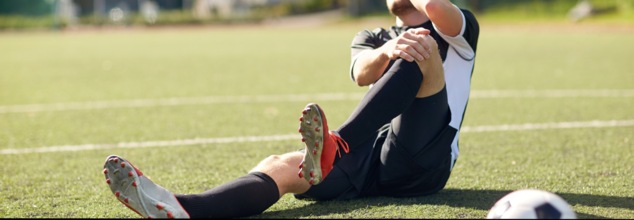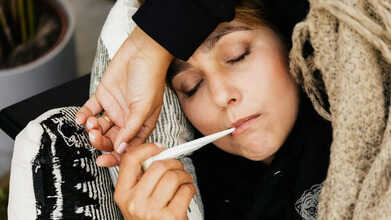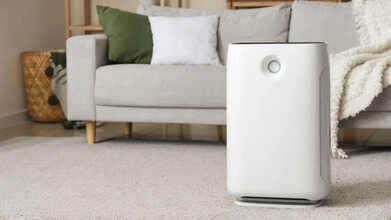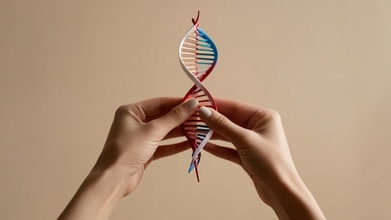- Health Conditions A-Z
- Health & Wellness
- Nutrition
- Fitness
- Health News
- Ayurveda
- Videos
- Medicine A-Z
- Parenting
Top Tips For Preventing ACL Injuries: Expert Physiotherapy Advice For Athletes

ACL injury (Credit: Canva)
The Anterior Cruciate Ligament (ACL), a vital ligament in your knee, is crucial for maintaining your stability and agility when playing sports. Regrettably, it is also among the most susceptible to harm. An ACL tear may be a game-changer for players, keeping them out of the game for months and interfering with their training. Fortunately, with the appropriate tactics, you can avoid these kinds of injuries.
Here is a compilation of professional physiotherapy advice, to help you avoid the injury ward and continue playing on the field.
1. Strengthening
Consider your body as a well-tuned device. One has to have a solid foundation in order to prevent ACL damage. This entails concentrating on building the quadriceps, hamstrings, and calf muscles—the muscles that surround your knee. Leg presses, lunges, and squats are excellent exercises for this. However, before that, it is essential to strengthen the gluteus maximus and medius muscles, minimizing rotational force and avoiding knee injuries. Including stability and balance training can help increase the durability of your proximal joints. Recall that a stronger body makes a greater barrier against possible harm.
2. Develop Your Method
In athletics, it's just as important how you move as how much you move. The significance of using correct technique, particularly when jumping and landing. With your knees slightly bent and your weight evenly distributed, practice a smooth landing. Refrain from landing with your knees bending inward as this may cause excessive strain on your ACL. You can improve your overall performance and lower your chance of injury by perfecting your movement patterns.
3. Use Caution When Warming Up
Make sure you're adequately warmed up before engaging in strenuous activity. A thorough warm-up helps your body get ready for the physical demands of your sport by boosting blood flow to your muscles. Include stretches and workouts that are energetic and imitate the actions you will be doing. This lessens the possibility of strain-related ailments and aids in your body's adaptation to the strain.
4. Include Training in Flexibility
An important factor in preventing injuries is flexibility. Stretching on a regular basis can help your muscles absorb shock more efficiently and increase your range of motion. Paying special attention to hamstring, quad, and calves stretches. Flexibility training of hamstrings and power training of all three quads, mainly rectus femoris helps a great deal. Pilates and yoga can also be helpful since they strengthen the core and increase overall flexibility, both of which assist knee stability.
5. Pay Attention to Your Body
Listening to your body is perhaps the most important piece of advice. Do not force yourself to continue if you are experiencing discomfort or exhaustion. Weariness and overuse can affect your form and raise your chance of injury. Get enough rest and recuperation, and if you're unsure about any pain or discomfort, consult your physiotherapist as soon as possible.
By following these expert physiotherapy tips, you can significantly reduce your risk of ACL injuries and keep performing at your best. Remember, prevention is always better than treatment. So gear up, stay proactive, and enjoy the game!
Flu Symptoms 2025: Three Easily Missed Symptoms Experts Warn About As UK Cases Rise

Credits: Canva
The public is being advised to limit close contact with others if they experience flu or Covid symptoms, as the NHS braces for a challenging winter ahead. A mutated, or “drifted”, version of the H3N2 flu strain is fuelling a faster and earlier rise in infections and hospital admissions in 2025. Dr Conall Watson, Consultant Epidemiologist at the UK Health Security Agency, has urged those who are eligible to get vaccinated at the earliest.
He said there are also everyday precautions that can help protect others, especially during the festive season. “If you have symptoms of flu or Covid-19, such as a high temperature, cough, or feeling tired or achy, you should try to reduce contact with other people, particularly those who are more vulnerable. Regular handwashing and good ventilation indoors both make a difference. If you need to go out while unwell, wearing a face covering is worth considering,” he added.
This guidance becomes even more important in the run-up to Christmas, when families tend to gather and older relatives, who face a higher risk of serious illness, are often present.
Flu Symptoms 2025: Less Obvious Symptoms People Often Miss
While many flu symptoms are widely recognised, some are less commonly associated with the illness. The NHS lists ten typical flu symptoms, which often appear suddenly.
Among these, three signs that people may overlook are trouble sleeping, a reduced appetite, and feeling unusually tired or drained. During the busy weeks leading up to Christmas, these symptoms can easily be dismissed as stress or exhaustion rather than flu.
Flu Symptoms 2025: Full List of Common NHS-Listed Signs
The remaining seven symptoms listed by the NHS include a sudden high temperature, body aches, a dry cough, sore throat, headache, diarrhoea or stomach pain, and feeling sick or being sick.
At the same time, the NHS is dealing with added pressure from a surge in winter viruses alongside a five-day strike by resident doctors, previously known as junior doctors. Health leaders and the Government have called on doctors to withdraw the strike, which ministers have described as reckless and irresponsible given the strain on services.
Flu Symptoms 2025: NHS Under Pressure as Winter Challenges Mount
Home Secretary Shabana Mahmood, as per The Independent, said that strikes within the NHS “undoubtedly” put lives at risk. Speaking to Sky News’ Sunday Morning With Trevor Phillips, she said, “We want to ensure the NHS is supported through a difficult winter and this flu outbreak we are currently seeing. It is important that everyone understands what is at stake.”
She also pointed to a difference between the position taken by resident doctors’ leadership and the views of individual doctors, noting that the situation remains sensitive as the NHS navigates one of its most demanding winter periods.
Flu Symptoms 2025: Who Can Still Get Vaccinated?
The NHS provides the flu vaccine free of charge to groups considered most at risk of serious illness. This includes people aged 65 and above, those with certain long-term health conditions, and pregnant women, as per the official NHS website.
The offer also extends to care home residents, carers who look after older or disabled individuals or receive a carer’s allowance, and people living with someone who has a weakened immune system. Frontline health and social care workers are also eligible and can usually receive the vaccine through their employer.
Children are included too. A nasal spray version of the flu vaccine is offered to children aged two and three, as well as school-going children from reception through to year 11.
This is because children tend to catch and spread flu more easily. Vaccinating them not only protects their own health but also helps reduce the risk for vulnerable people around them who could become seriously ill.
Can Overusing Air Purifiers Harm Your Lungs? Expert Explains

CREDITS: CANVA
Delhi residents continue to struggle with deteriorating air quality, which is taking a visible toll on overall health. The Air Quality Index (AQI) across Delhi NCR crossed 400 on December 15, 2025, placing it firmly in the ‘hazardous’ category. With breathing outdoor air becoming increasingly difficult, many people are turning to air purifiers for relief, both at home and in offices. Yet a common concern persists. Are air purifiers truly safe, or do they come with hidden drawbacks? And can excessive use cause problems of its own? We got in touch with Dr Aditya Nag, Assistant Professor, Department of Respiratory Medicine, NIIMS Medical College and Hospital, to know more about the same.
What Is An Air Purifier?
An air purifier, often referred to as an air filtration system, is designed to clean indoor air by filtering out harmful particles and pollutants. It works by pulling in air from the room, passing it through layers of filters, and releasing cleaner air back into the space. These devices are widely used in homes and offices to create a healthier and more breathable environment.
Dr Aditya Nag said, “Air purifiers are particularly helpful in removing dust, pollen, pet hair, mould spores, and other microscopic particles that can trigger allergies or worsen respiratory conditions. Their internal filters trap these pollutants, helping improve indoor air quality. In simple terms, they aim to make the air inside cleaner, safer, and easier to breathe.”
Are Air Purifiers Safe To Use?
Air purifiers rely on fans to draw air through one or more filters that capture pollutants before circulating cleaner air back into the room. They come in many forms, from portable units that can be shifted between rooms to wall-mounted models. There are also compact desktop versions and even wearable purifiers available today.
According to our health expert, air purifiers are generally safe and effective at improving indoor air quality, provided the right type is chosen and maintained properly. Models that use True HEPA filters and do not produce ozone are considered the safest. However, ozone-generating purifiers, certain UV-C devices without adequate shielding, and units with poorly maintained filters can release harmful by-products. These secondary pollutants may irritate the lungs and airways. This is why it is important to check safety certifications, replace filters on time, and avoid technologies known to emit ozone.
Overusing Air Purifiers Is Bad For Lungs?
Our expert points out that running an air purifier nonstop on high settings in tightly sealed rooms can reduce indoor humidity levels significantly. This drop in moisture can be uncomfortable for the respiratory system. “While clean air is important, the lungs function best when the air also has enough moisture,” he explains.
Very dry indoor air can irritate the nose, throat, and airways, leading to symptoms such as dryness, scratchy throat, persistent dry cough, burning eyes, and even frequent nosebleeds, especially in the morning.
Dr Nag stresses that air purifiers remain extremely useful, particularly for children, older adults, and people with asthma or allergies. The key is balanced use. He advises switching to auto mode instead of running turbo mode all the time, avoiding completely sealed rooms, and maintaining indoor humidity between 40 and 60 percent. This can be done with a humidifier or simple home measures.
Is It Safe to Sleep Near an Air Purifier?
Many people place air purifiers in their bedrooms, often close to the bed, which raises questions about safety during sleep. According to our expert, sleeping near an air purifier is generally safe and can even be beneficial, as long as basic precautions are followed.
Most modern air purifiers, especially those equipped with HEPA filters, are built for continuous use and operate quietly enough for bedrooms. By reducing allergens and airborne particles overnight, they may help improve sleep quality, particularly for people with allergies or breathing issues.
What To Look For In An Air Purifier?
When choosing an air purifier, it is important to look for models with True HEPA (H13 or H14) filters and activated carbon layers for effective removal of particles and odours. Check whether the purifier is suitable for your room size by reviewing its CADR, or Clean Air Delivery Rate. Noise levels are another key factor, especially if the device will be used in a bedroom.
It is also wise to consider the cost and frequency of filter replacement. Be cautious of purifiers that rely on ozone-producing ionisers or certain UV features. A reliable air purifier should offer multi-stage filtration, cover the intended space efficiently, and operate quietly without compromising safety.
This One Gene May Be Triggering Mental Illness In Children; Scientists Say It Changes Everything

Credits: Canva
For decades, mental health issues were explained as a result of many small genetic risks piling up over time. However, a study led by German scientists has now identified one gene whose specific variants could appear to directly impact psychiatric symptoms, even in the absence of neurological problems. In rare cases, the study suggests, a single faulty gene may be enough to directly cause mental disorders, much earlier tan doctors typically expect.
Scientists studying mutations in the GRIN2A gene found evidence that certain rare variants do not increase the likelihood of mental illness, but they appear to trigger it. This happens due to a clear biological mechanism, often in the beginning of childhood itself. The findings challenge long-held assumptions about how conditions like schizophrenia, anxiety, and mood disorders develop.
The findings are published in journal Molecular Psychiatry. The study describes GRIN2A null variants as the first known example of a single gene directly causing early-onset and even isolated psychiatric disorders, including early-onset schizophrenia.
How An Unexpected Pattern Emerged
The research team, led by Johannes Lemke from the University of Leipzig Medical Center, did not set out to study psychiatric genetics. They were working with a global registry of people diagnosed with GRIN2A-related disorders, most of whom were tested as children for epilepsy or developmental delays.
When the researchers began asking physicians about mental health diagnoses, a striking pattern emerged. Out of 121 individuals with disease-causing GRIN2A mutations, 25 had been diagnosed with psychiatric disorders. Of those 25, 23 carried null variants that completely shut down the gene’s function. In contrast, only 2 of 37 people with missense variants, which alter but do not eliminate the protein, developed mental illness.
To understand how high and unusual this risk was, the team of researchers compared their findings with 21 years of national health records in Finland. This included records of over 5 million people, and the results were stark.
The analysis of this large population showed that by age 12, carriers of GRIN2A null variants showed an 87-fold higher rate of psychotic disorder compared to the general population. Although this estimate was based on just four cases, risks for mood disorders were nearly 12 times higher, and anxiety disorder six times higher.
What stood out most was timing. Schizophrenia typically appears in late adolescence or early adulthood. Anxiety and mood disorders usually emerge in the teenage years or later. In people with GRIN2A null variants, symptoms began as early as ages 8, 10, or 12.
How Does This Gene Operate In Your Brain?
GRIN2A carriers instruction for making a protein known as GluN2A. This is a critical component of NDMA receptors, which help brain cells respond to glutamate, brain's main excitatory chemical messenger.
When GluN2A is missing, these receptors cannot assemble or function normally. This is what leads to disruption in brain signaling that appears to directly drive psychiatric symptoms. Unlike polygenic risk scores that reflect tiny contributions from thousands of genes, GRIN2A null variants remove a key part of the brain's signaling machinery in one decisive step.
Interestingly, people with missense mutations had similar rates of epilepsy and intellectual disability as those with null variants. But when it came to psychiatric illness, only null variants carried substantial risk.
Mental Illness That Comes Without Warning Signs
Six people in the study developed psychiatric disorders without any intellectual disability. Two of them never experienced epilepsy. Without any known family history, these individuals would have never undergone a genetic testing otherwise. Current psychiatric guidelines also do not recommend genetic screening for isolated mental illness. This is because most participants who were initially tested for seizures or developmental delays, cases with only psychiatric symptoms are likely undercounted. The true prevalence may be higher.
A Targeted Treatment Shows Early Promise
Four people with GRIN2A null-related psychiatric disorders were treated with the amino acid L-serine for over a year, at doses up to 500 mg per kilogram daily. All four showed improvement. In one case, hallucinations stopped entirely. Others saw paranoid symptoms resolve, behavioral control improve, or seizures decrease.
L-serine converts to D-serine in the brain, which helps activate NMDA receptors. Boosting this pathway may compensate for the missing GluN2A subunits, offering a targeted approach rather than trial-and-error treatment.
Rethinking Early Diagnosis
More than 80 percent of people with GRIN2A null-related mental illness also had epilepsy at some point, though seizures did not predict who developed psychiatric symptoms. In most cases, mental illness appeared after epilepsy had resolved.
The findings suggest genetic testing could eventually become part of evaluating early-onset psychiatric disorders. For a small but significant group of patients, the cause of mental illness may be clearly identifiable, biologically grounded, and potentially treatable.
For most people living with mental disorders, the origins will remain complex. But this research shows that, sometimes, the answer may lie in a single gene.
© 2024 Bennett, Coleman & Company Limited

